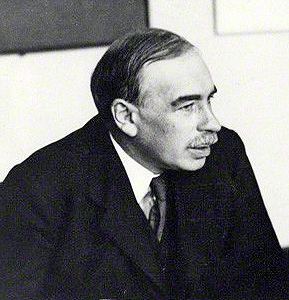 | ||
The bancor was a supranational currency that John Maynard Keynes and E. F. Schumacher conceptualised in the years 1940–1942 and which the United Kingdom proposed to introduce after World War II. The name was inspired by the French banc or ('bank gold'). This newly created supranational currency would then be used in international trade as a unit of account within a multilateral clearing system—the International Clearing Union—which would also have to be founded.
Contents
Overview
John Maynard Keynes proposed an explanation for the ineffectiveness of monetary policy to stem the depression, as well as a non-monetary interpretation of the depression, and finally an alternative to a monetary policy for meeting the depression. Keynes believed that in times of heavy unemployment, interest rates could not be lowered by monetary policies. The ability for capital to move between countries seeking the highest interest rate frustrated Keynesian policies. By closer government control of international trade and the movement of funds, Keynesian policy would be more effective in stimulating individual economies.
Bancor would not be an international currency. It would rather be a unit of account used to track international flows of assets and liabilities, which would be conducted through the International Clearing Union. Gold could be exchanged for bancors, but bancors could not be exchanged for gold. Individuals could not hold or trade in bancor. All international trade would be valued and cleared in bancor. Surplus countries with excess bancor assets and deficit countries with excess bancor liabilities would both be charged to provide symmetrical incentives on them to take action to restore balanced trade. In the words of Benn Steil,
Each item a member country exported would add bancors to its ICB account, and each item it imported would subtract bancors. Limits would be imposed on the amount of bancor a country could accumulate by selling more abroad than it bought, and on the amount of bancor debt it could rack up by buying more than it sold. This was to stop countries building up excessive surpluses or deficits. Each country's limits would be proportional to its share of world trade ... Once initial limits had been breached, deficit countries would be allowed to depreciate, and surplus countries to appreciate, their currencies. This would make deficit country goods cheaper, and surplus country goods more expensive, with the aim of stimulating a rebalancing of trade. Further bancor debit or credit position breaches would trigger mandatory action. For chronic debtors, this would include oligatory currency depreciation, rising interest payments to the ICB Reserve Fund, forced gold sales, and capital export restrictions. For chronic creditors, it would include currency appreciation and payment of a minimum of 5 percent interest on excess credits, rising to 10 percent on larger excess credits, to the ICB's Reserve Fund. Keynes never believed that creditors would actually pay what in effect were fines; rather, he believed they would take the necessary actions ... to avoid them.
Bretton Woods conference
Keynes was able to make his proposal the official British proposal at the Bretton Woods Conference but it was not accepted. Rather than a supranational currency, the conference adopted a system of pegged exchange rates ultimately tied to physical gold in a system managed by the World Bank and IMF. In practice, the system implicitly established the United States dollar as a reserve currency convertible to gold at a fixed price on demand by other governments. The dollar was implicitly established as the reserve by the large trade surplus and gold reserves held by the US at the time of the conference.
Proposed revival
Since the outbreak of the financial crisis in 2008 Keynes's proposal has been revived: In a speech delivered in March 2009 entitled Reform the International Monetary System, Zhou Xiaochuan, the governor of the People's Bank of China called Keynes's bancor approach "farsighted" and proposed the adoption of International Monetary Fund (IMF) special drawing rights (SDRs) as a global reserve currency as a response to the financial crisis of 2007–2010. He argued that a national currency was unsuitable as a global reserve currency because of the Triffin dilemma—the difficulty faced by reserve currency issuers in trying to simultaneously achieve their domestic monetary policy goals and meet other countries' demand for reserve currency. A similar analysis can be found in the Report of the United Nation's "Experts on reforms of the international monetary and financial system" as well as in the IMF's study published on 13 April 2010.
